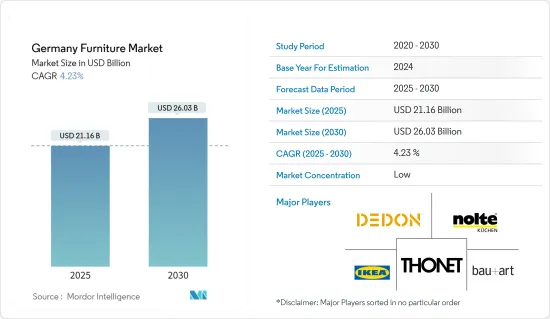PUBLISHER: Mordor Intelligence | PRODUCT CODE: 1643000

PUBLISHER: Mordor Intelligence | PRODUCT CODE: 1643000
Germany Furniture - Market Share Analysis, Industry Trends & Statistics, Growth Forecasts (2025 - 2030)
The Germany Furniture Market size is estimated at USD 21.16 billion in 2025, and is expected to reach USD 26.03 billion by 2030, at a CAGR of 4.23% during the forecast period (2025-2030).

Germany ranks among the top furniture markets in Europe, characterized by robust domestic demand and a reputation for high-quality manufacturing. The German furniture landscape encompasses diverse segments, including residential, office, kitchen, and bathroom furnishings. Notably, the kitchen segment is witnessing a surge, marked by rising sales, technological advancements, and innovative product designs. While bedding and home furnishings in Germany lean toward foreign sales, driving growth primarily through exports, only those businesses that prioritize exports are poised to benefit from this upward trend.
Recently, there has been a heightened emphasis on eco-friendly and sustainable furniture. Natural materials, such as organic fabrics and wood, are gaining traction. Furthermore, there is an increasing appetite for intelligent and multifunctional furniture, underscoring a trend toward maximizing space utilization. This shift reflects a broader consumer preference for environmentally conscious and space-efficient living solutions.
Germany Furniture Market Trends
Home Decor Furniture Fueling the Market
In recent years, there has been a growing emphasis on home decor and interior design worldwide, including in Germany. The increasing popularity of home improvement shows, social media platforms dedicated to interior design, and a general interest in creating aesthetically pleasing living spaces have contributed to this trend. The rising focus on home decor is positively impacting the furniture market in Germany. Nowadays, buyers are more likely to spend money on fine furniture and accessories that complement their interior design themes and personal styles. As a result, there is a greater need for a broad range of furniture pieces, including couches, dining sets, coffee tables, shelving, and accent pieces. Furthermore, the availability of online shopping platforms and e-commerce has made it easier for consumers to explore and purchase furniture products from a vast range of options. This has expanded the market reach for both local and international furniture brands, providing consumers with more choices and convenient shopping experiences.
Growing Potential in the German Online Furniture Market
The introduction of augmented reality apps and 3D product visualizations by German retailers has increased demand for furniture products through e-commerce portals. The online furniture business in Germany is starting to pick up steam as companies like Ikea and Otto implement omnichannel and other tactics. Retailers can overcome the resistance by implementing omnichannel concepts that integrate physical showrooms with online distribution channels, technological advancements, and simple, user-friendly exchange procedures for online purchases. This will facilitate the expansion of furniture sales online, which has great promise for the German furniture industry.
Germany Furniture Industry Overview
The German furniture market is fragmented, with numerous competitors. There are both domestic and foreign competitors in this very competitive market. Players occupy the conventional sector, causing the market to be fragmented. As e-commerce expands, businesses are starting to sell their products online. Among the well-known companies are Thonet, Dedon, Nolte, IKEA, and Bau+Art.
Additional Benefits:
- The market estimate (ME) sheet in Excel format
- 3 months of analyst support
TABLE OF CONTENTS
1 INTRODUCTION
- 1.1 Study Assumptions and Market Definitions
- 1.2 Scope of the Study
2 RESEARCH METHODOLOGY
3 EXECUTIVE SUMMARY
4 MARKET DYNAMICS AND INSIGHTS
- 4.1 Market Overview
- 4.2 Market Drivers
- 4.2.1 Increasing Construction and Renovation Activities
- 4.2.2 Growing Potential in the German Online Furniture Market
- 4.3 Market Restraints
- 4.3.1 High Price of Supply Chain and Logistics
- 4.4 Market Opportunities
- 4.4.1 Manufacturing of Multifunctional Furniture
- 4.4.2 E-commerce and Online Retail Offer an Opportunity for Growth
- 4.5 Industry Value Chain Analysis
- 4.6 Industry Attractiveness - Porters' Five Forces Analysis
- 4.6.1 Threat of New Entrants
- 4.6.2 Bargaining Power of Buyers
- 4.6.3 Bargaining Power of Suppliers
- 4.6.4 Threat of Substitutes
- 4.6.5 Intensity of Competitive Rivalry
- 4.7 Insights into Technological Innovations in the Market
- 4.8 Impact of COVID-19 on the Market
5 MARKET SEGMENTATION
- 5.1 By Material
- 5.1.1 Wood
- 5.1.2 Metal
- 5.1.3 Plastic & Other Furniture
- 5.2 By Application
- 5.2.1 Home Furniture
- 5.2.2 Office Furniture
- 5.2.3 Hospitality Furniture
- 5.3 By Distribution Channel
- 5.3.1 Supermarkets & Hypermarkets
- 5.3.2 Specialty Stores
- 5.3.3 Online
6 COMPETITIVE LANDSCAPE
- 6.1 Market Concetration Overview
- 6.2 Company Profiles
- 6.2.1 IKEA
- 6.2.2 Otto
- 6.2.3 Thonet
- 6.2.4 Nolte
- 6.2.5 Dedon
- 6.2.6 bau+art
- 6.2.7 Zeitraum
- 6.2.8 Brunner
- 6.2.9 Rolf Benz
- 6.2.10 Noah-living*
7 FUTURE OF THE MARKET
8 DISCLAIMER AND ABOUT US




